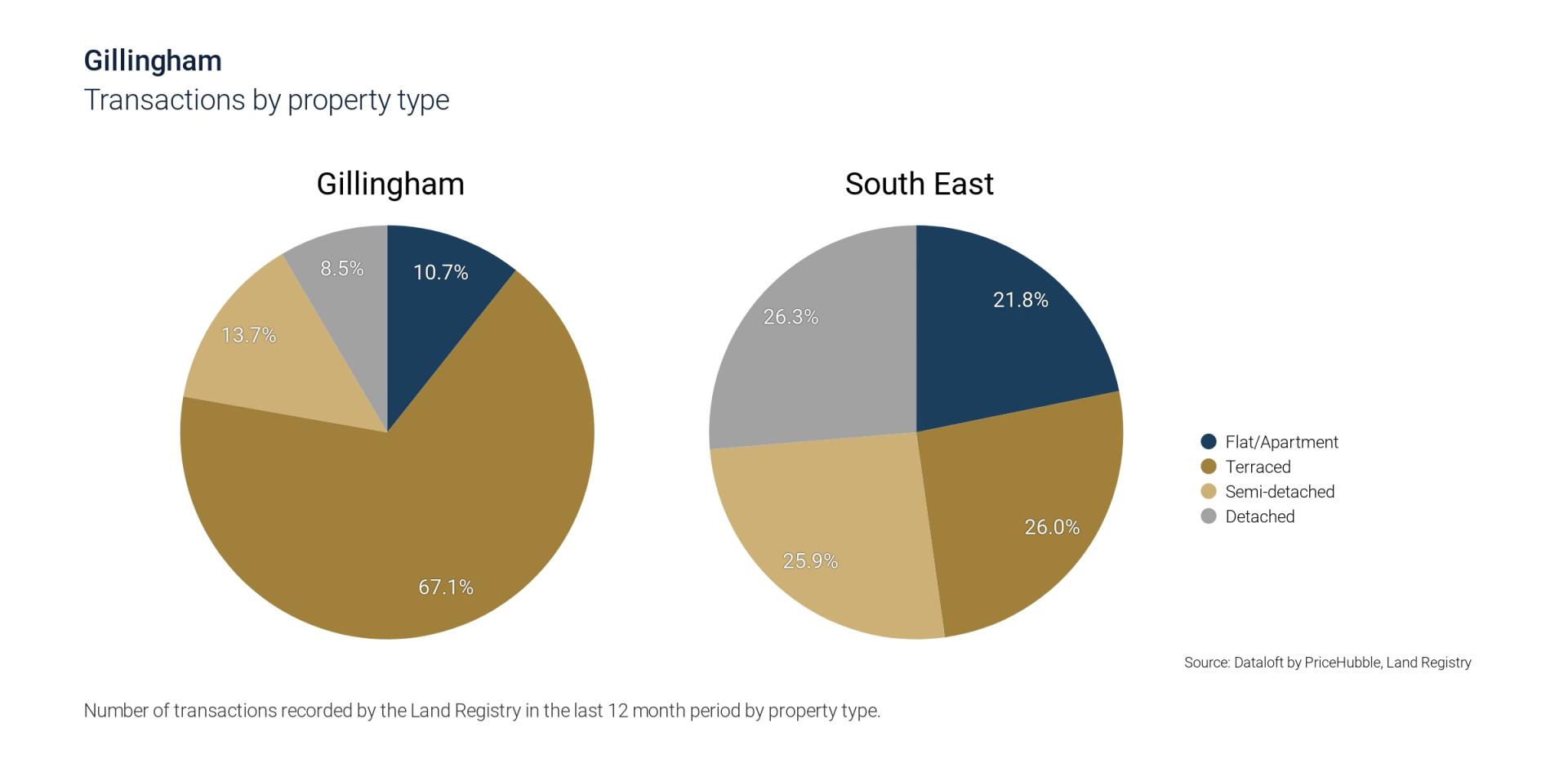Gillingham, Kent, a town known for its rich maritime history and bustling community, has seen significant fluctuations in its property market over the past 12 months. With an average sales price of £260,832, the total value of property sales amounted to £116,276,246. In this blog post we delve into the trends, price changes, and transactional dynamics that have shaped the property landscape in Gillingham, providing a comprehensive overview for prospective buyers, sellers, and investors.
What's happening to the average sales prices by property type?
The property market in Gillingham, consists of pretty much all types of property. Flats, which constituted 10% of sales, achieved an average sales price of £166,341. In contrast, houses, which made up a more significant portion of transactions, had an average price of £274,421. The highest recorded sale for a flat was £292,500, while a house reached the dizzying heights of £825,000. You can see a breakdown by the type of property in the graph below. These figures highlight the varying demand and value attributed to different property types within the market.
How does Gillingham compare to the rest of the South East?
When compared to the broader South East region, Gillingham's property prices present an interesting picture. For example, the average price for detached houses in Gillingham stands at £517,494, which is notably lower than the South East average of £639,923. Similarly, semi-detached houses in Gillingham average at £347,971, compared to £404,824 in the South East. Terraced houses and flats also follow this trend, indicating that while Gillingham offers relatively more affordable options, it might attract buyers looking for better value for money within the region. This is what we expect with the Medway Towns in general offering more value for your money compared to the rest of the South East.

Annual Change in Average Prices
The annual change in average prices reveals a nuanced view of the market's dynamics. Over the past year, Gillingham saw a 2% decrease in house prices, with Gillingham performing slightly better than the 2.7% drop seen in the South East and a 3% decrease across England and Wales. Despite this decline, house prices in Gillingham are still 17% higher than they were five years ago, suggesting long-term growth and stability in the market.
Transaction Volumes and Trends
The number of property transactions in Gillingham has experienced a significant downturn, with a 38.2% decrease over the past 12 months. This decline is more pronounced than the 43.9% drop in the South East and the 42.3% fall across England and Wales. The total number of transactions stood at 459. This is reflecting the challenges the market currently faces, which is most probably down to economic factors such as the increase in interest rates, and inflation being high amongst other external factors. We think people are just sitting tight to see what the next year or so brings but people who need to move will continue to.
Monthly Transactions and Trends
With us breaking down the transactions by month it provides a clearer picture of the market activity. The peak months for transactions were June and July 2023, with 56 and 55 transactions respectively. However, there has been a steady decline in the latter part of the year, with April 2024 recording only a few transactions. This pattern indicates a seasonal trend, with higher activity during the summer months and a slowdown towards the year-end and early new year. Which has been a bit of a shift from the traditional beginning of the year peak and the usual summer slowdown. It will be interesting to see if this becomes the new normal.

Transactions by Price Bands
By analysing transactions by price bands offers us insights into the affordability and what the demand is within different price segments. Although in Gillingham there are 2 main segments. With 46% of transactions were within the £100k-£250k range, followed by 47.9% in the £250k-£500k range. This distribution suggests a strong market for mid-range properties, which would indicate the type of buyer would be first time buyers and young families, this also makes it extremely attractive for investors. In contrast, the South East shows a broader distribution across higher price bands, indicating varied market dynamics.

Property Type Distribution
The distribution of transactions by property type further emphasises the market preferences. In Gillingham, 67.1% of transactions were for terraced houses, 13.7% for semi-detached, and 10.7% for flats/apartments. Detached houses accounted for only 8.5%. This contrasts with the South East, where flats and apartments made up 21.8% of transactions, indicating a higher preference for diverse housing options in the broader region. This again backs up the above point about who the type of buyers are most likely to be.
Key Market Metrics
Key market metrics over the past 12 months reinforce the overall trends observed. Gillingham's average property value of £260,832 represents a 2% decrease, with 459 transactions reflecting a 38.2% drop. These figures highlight the challenges in the market but also underscore the relative affordability and potential opportunities for buyers.
Conclusion
The property market in Gillingham, Kent, has faced its share of challenges over the past year, with decreasing transaction volumes and slight declines in average prices. However, the long-term growth in house prices and the comparative affordability of the market present opportunities for buyers and investors. As the market adjusts to broader economic conditions, Gillingham remains a town with potential, offering a range of property options to suit various preferences and budgets. Prospective buyers and sellers should stay informed and consider these trends when making their next move in the property market.
We are still seeing that when houses are priced properly in Gillingham that there is still buyers out there who are looking to buy. We are also seeing demand for flats in the area dropping as we think buyers requirements have changed especially since lockdown and the need to have extra space especially a garden.



 By
By 



Share this with
Email
Facebook
Messenger
Twitter
Pinterest
LinkedIn
Copy this link